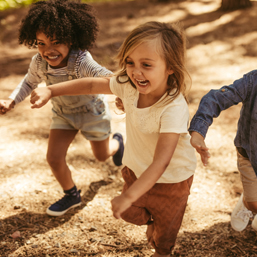-
Written by Sarah Reader
In 2020, ParticipACTION published a report card for Canadian children on their daily behaviors such as active play, overall physical activity, sedentary behaviors, and sleep. The score for Overall Physical Activity was a D+ as only 39 percent of children aged 5 to 17 are getting the recommended daily amount of physical activity - this number is even lower in girls. The grade for Active Play (non-organized/unstructured leisure activities) was an F; this is a decline from a D assigned in 2018 (participaction.com).
Our children are more sedentary than ever, and their physical and mental health is declining because of it. Research shows us that we can increase these grades by offering more unstructured, outdoor play for our children. When kids are outside, they move more, sit less, and play longer.
A terrific way to enhance our children’s outdoor play is with loose parts. Loose parts are any materials that can be moved, carried, built and taken apart, lined up stacked together, and tinkered with. Loose parts aren’t prescriptive; there are no set directions, they offer limitless possibilities, and inspire creative play. Dynamic spaces where children can explore, create, imagine, and manipulate their environment through play helps to develop their imaginative learning, physical, social, and decision-making skills.
Here are five tips on how to incorporate loose parts into your child’s outdoor play:
- Variety is the spice of life. When curating loose parts for your child’s outdoor play, have a variety of pieces available including those that your child would normally never interact with such as pvc pipes, tires, or large spools. One of the best pieces I had at an adventure playground is an old fiberglass bathtub insert; it is light enough for the children to move and it became a pirate ship, a bed, a chariot, and more! You don’t have to head out and purchase anything new or fancy; the best loose parts pieces are those that you have in your house: buckets, cardboard, gardening tools, fabric, pots/pans, water, scrap wood, etc. Having a variety of natural pieces such as sticks, pinecones, or dirt is also a terrific way to introduce different sensory experiences.
- Use the environment. Do you have a hill near your house or woods? Are there large rocks to play on or trees to help create the backdrop for an imaginary world? When choosing parks to run an adventure playground, I looked for ones that had natural elements that I could incorporate into the children’s play like sand, rocks, trees, and hills. When your kids play out in nature, loose parts are already provided - the woods become their playground, the rocks and trees become their equipment, and they are exposed to endless hours of creation and imagination.
- Plan for the elements. One of the beautiful things about loose parts is they can be used in all types of weather and environments. The key is to use the loose parts best suited for the elements. For instance, cardboard is a fantastic play piece, but put it on snow and it becomes extremely slippery. During the winter, kids are wearing mitts or gloves, so you want to use larger pieces that don’t require fine motor skills and won’t get lost in the snow. In the hot summer months, offer your kids loose parts that inspire their imaginative/constructive play instead of highly active play.
- Don’t be afraid of risky play. Kids are more active when they have some freedom to roam and take risks. There are many different types of risky play: rough and tumble, play with tools, play at great heights, closely supervised play with dangerous elements (i.e., fire), play at high speeds, and play where kids ‘disappear’ or get lost. Unstructured, active play outdoors, with its risks, is essential for healthy child development. If you were never exposed to risky play opportunities as a child, it can be a little scary to allow your child to do so - and that’s okay! Take small steps and offer the environment for them to encounter risk through loose parts and learn to be more comfortable with it alongside your kids.
- Let your child lead the play. It can be tempting to lead your children in play - help them create and direct their activities. But the true magic of play comes when the activities are freely chosen, intrinsically motivated, and personally directed. Children learn best when they can play freely, when they are empowered to take control of their own play and environments. Allow your children the freedom to build, imagine, and create in their own way - get down and play with them or start to build and create yourself.
We know all the incredible benefits of unstructured, outdoor play - add some loose parts and watch the magic happen!
Sarah has a Bachelor of Physical Education from the University of Alberta and was the supervisor for The City of Calgary’s Mobile Adventure Playground. As the owner of Playful Adventures (Instagram: @playfuladventures), she is passionate about bringing back unstructured, loose parts, outdoor play. Reach her at This email address is being protected from spambots. You need JavaScript enabled to view it.
